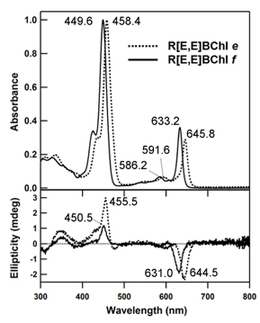Research Abstract
巨大集光アンテナを駆動させる7番目の細菌型クロロフィル
A seventh bacterial chlorophyll driving a large light-harvesting antenna
2012年9月19日 Scientific Reports 2 : 671 doi: 10.1038/srep00671

新しいクロロフィル色素の発見は、光合成のメカニズムと進化に対してより深い知見を与えてくれる。バクテリオクロロフィルfの名前と構造は、類似する色素に基づいて約40年前に提唱されていたが、これまでに自然界では全く観察されてこなかった。我々は、クロロフィル骨格のC20位にメチル基を転移させる酵素遺伝子bchUを、自然形質転換法で欠損させることによって、もともとはC20位にメチル基を有するバクテリオクロロフィルeを合成する緑色硫黄細菌Chlorobaculum limnaeumから、バクテリオクロロフィルfを蓄積する変異体を作製することに成功した。この新しい色素分子は、光合成細菌の巨大集光アンテナ系であるクロロソームにおいて、自己会合体を形成するが、その最長波長吸収極大(Qyピーク)が、これまでに報告されてきたクロロソームの中で最も短波長側にあることが確認された。このQyピークが示す705 nmという波長は、太陽の光量子束スペクトルの最大値(~700 nm)とほぼ同じであった。また、バクテリオクロロフィルf型のクロロソームでは、その自己会合体から、ベースプレートタンパク質内の約100 nmも高波長側(低エネルギー側)にあるバクテリオクロロフィルへと、光エネルギーを伝達することが可能であった。従って、バクテリオクロロフィルfは、新たなバイオエネルギー系の応用開発においても、有用な素材となりうる。
原田 二朗1, 溝口 正2, 塚谷 祐介2, 野口 正人1 & 民秋 均2
- 久留米大学医学部 医化学講座
- 立命館大学大学院 生命科学研究科
The discovery of new chlorophyllous pigments would provide greater understanding of the mechanisms and evolution of photosynthesis. Bacteriochlorophyll f has never been observed in nature, although this name was proposed ~40 years ago based on structurally related compounds. We constructed a bacteriochlorophyll f–accumulating mutant of the green sulfur bacterium Chlorobaculum limnaeum, which originally produced bacteriochlorophyll e, by knocking out the bchU gene encoding C-20 methyltransferase based on natural transformation. This novel pigment self-aggregates in an in vivo light-harvesting antenna, the chlorosome, and exhibits a Qy peak of 705 nm, more blue-shifted than any other chlorosome reported so far; the peak overlaps the maximum (~700 nm) of the solar photon flux spectrum. Bacteriochlorophyll f chlorosomes can transfer light energy from core aggregated pigments to another bacteriochlorophyll in the chlorosomal envelope across an energy gap of ~100 nm, and is thus a promising material for development of new bioenergy applications.

